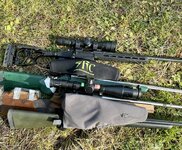Writing this, I recognize that my experience is specific, and maybe experienced shooters know things I didn't know when it happened. I also tend to be rough on tools and my truck, cause they are meant to be used. I took it too far with my rifle, not that I was abusing it. But, you don't know what you don't know.
Thank you for responding.
The blown primer was 100% user error, I should have been more careful. It was a rainy, snowy day on an elk hunt. At the time, my rifle didn't look much different than some of the pics with rifles in the snow. The snow and water had no direct effect on my rifle. It wasn't going to rust and it wasn't going to ruin the synthetic stock. I didn't care that my rifle was wet or snowy.
The issue only came during the operation of my rifle. I should have cared about my chamber/ammo getting even a little wet. I knew that water could cause issues, but I was treating my rifle like a tool and just hunting. And, I had proven my rifle in wet weather.
Back to the Colorado hunt, I blew a primer in my Nucleus, running a decent but not visibly hot load in my 7 sherman short mag 180 VLD at 3050 with H1000. At that time, I just had a scope cover and didn't worry about the moisture on the rifle. I shouldn't have shot it as "moist" as it was without checking the chamber and ammo. After that, made my cover. I also went to a slower powder to reduce the peak pressure and didn't chase the extra velocity it could get me. My rifle was probably drier at that time than times during my AK hunt.
The issue here isn’t some water in a chamber- literally millions of rounds of ammo are shot in total downpours ever year. Rain, water, snow, dirt are all realities of life and the guns must work in those conditions.
It’s a combination of things that starts with people getting cute with chamber specs, loads, and actions. “Tight” chambers “for accuracy”, bullets kissing, touching, or near the lands; neck sizing only, loads too hot just “going by pressure signs”, and reusing brass too many times are all problems. That is gamer, sitting on a bench nonsense.
Field rifles, chambers, and throats need correct tolerances for field use. Loads should not be run “near, but below pressure signs”, bullets need to be nowhere near the lands, and brass shouldn’t be reused 10 times. Doing so- rifles should have zero issues being submerged in water, then having the bolt cracked to drain it and then firing. Do the same with how most load ammo, how people want the chambers cut, and crappy rifles- yes you can have issues.
Field guns aren’t match guns.
I am 100% on board with the "rifles are tools" idea. I actually chose the Nuke based on the internet reputation of the Mausinfield being a crappy "range action" not feeling all smooth and buttery in the store, but being a performer in the field. Not sure the whole truth, but I read lots of buzz about a really rainy/messy match where "all the other actions went down but someone running the new Mausingfield ran like a champ. I got to talk with shooters who new Ted personally and had run the Mausingfield. I liked the idea that it had the "battle proven" ejector and extractor. (I was also switching from Savage actions so my prefits would fit.) My Nuke is single digit off the initial release. I know Ted makes a generous bolt "tolerance" and I have felt it comparing actions with tighter bolt/race specs at a couple dust bowl matches.
The Mausingfield is a very good action that is hampered by a very sub par trigger system. With a different trigger system they would be the action I use for everything.
It was a Savage that got the moon dust treatment. It was a rifle match with lots of people are walking and the dust is easily blown and lifted. One compounding factor is that I suppose matches require the bolt open with chamber flag--I don't hunt with my bolt open. It was years ago, but it was one of my first rifles, it was a Savage but I can't remember if it was a new 12 FV or if it was a different model. Hunting and other matches, I got that rifle and others really dusty without failure. That day, the extra dirt pushed it over the edge.
This is not uncommon at all with Savages, and lots of other action, though Savages are at the top of the list for mechanical failures when used, especially in non sterile conditions. They simply have way less margin for error in reliably feeding and functioning than others.
I’m not trying to harp on you, or anyone else. All equipment pushed hard enough will fail, however if you are going to base your decisions on two objectively compromised systems, then yes you will think every rifle needs a condom to work.
The difference between a R700 based action and trigger, or Savage rifle with loads that are worked up as most do, with compromised chambers and throats- and a robust rifle system from Tikka, Blaser, AI, Sako S20 or TRG, Sauer, etc, or in most cases a M70 with old style triggers and correct ammo- is worlds apart.
There is a demonstrable difference between rifle systems and where each consistently fails.

